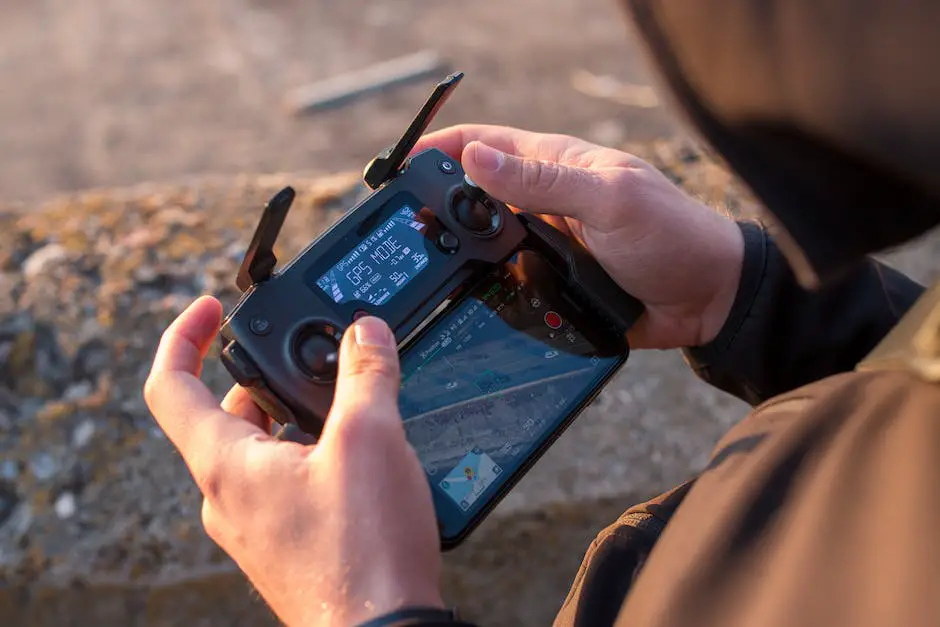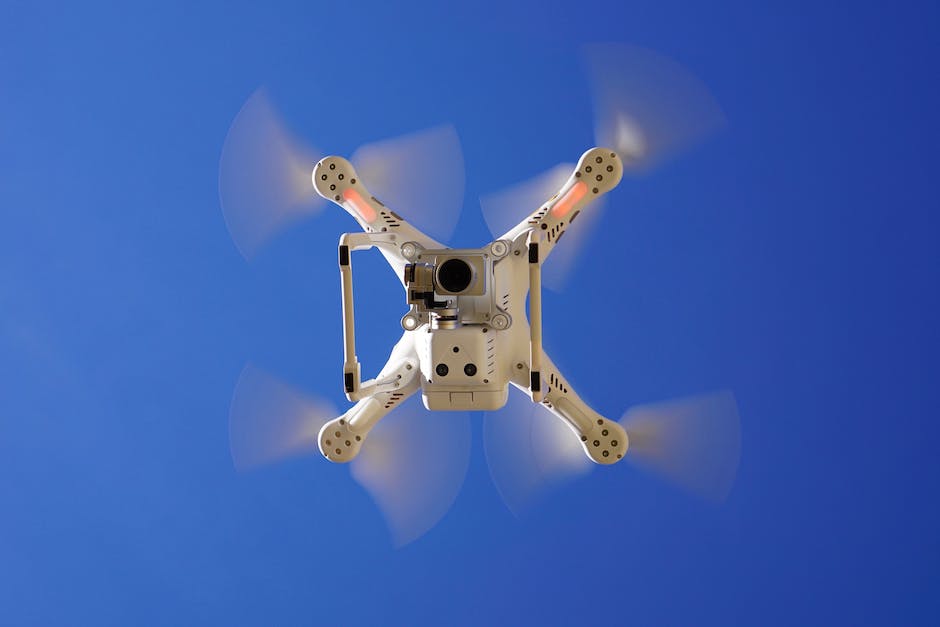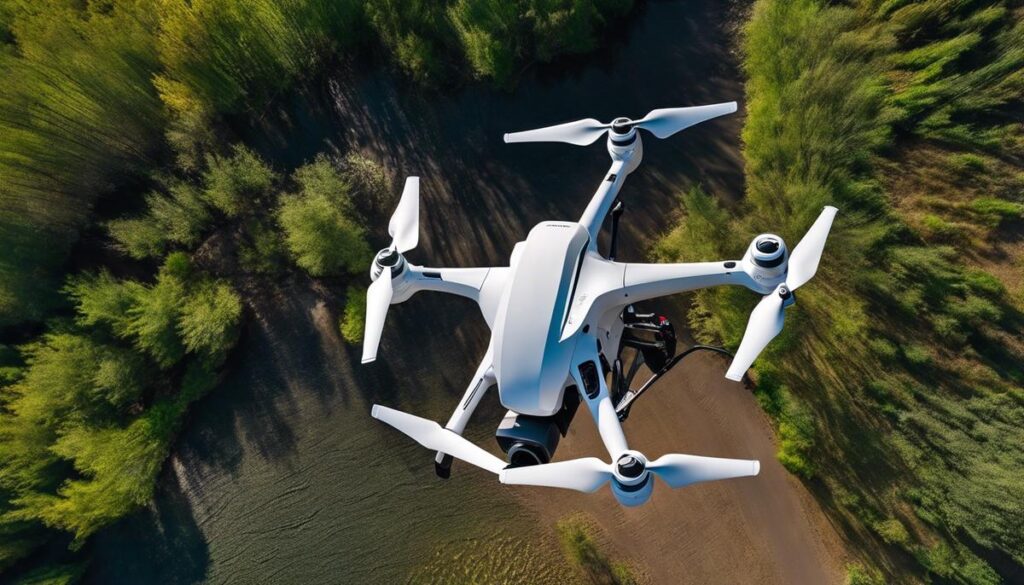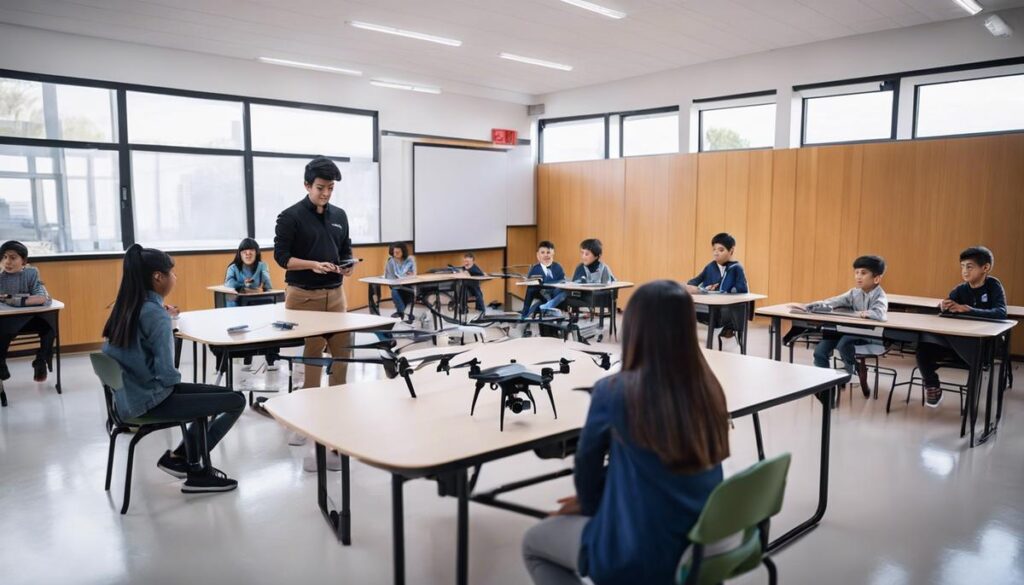Welcome to the fascinating world of commercial drone operations! Whether you are an aspiring pilot or an experienced flying ace, understanding the FAA Part 107 regulations is crucial to safely and legally unleash the full potential of your drone. In this comprehensive guide, we will cover the basics of FAA Part 107, drone registration and pilot certification, operational rules and limitations, airspace and flight restrictions, aeronautical knowledge and weather, emergency procedures and maintenance, and exam preparation. Lastly, we will touch on continuing education as a drone operator and staying up-to-date with the latest FAA updates.
Understanding FAA Part 107
The Federal Aviation Administration (FAA) Part 107 regulations govern the use of drones for commercial purposes in the United States. These rules are crucial for ensuring the safe integration of drones into the national airspace system and establishing a framework for their operation. Whether you’re considering launching a drone-based business or utilizing drones in your current operations, understanding and adhering to these regulations is not only essential for safety but also for compliance with the law.
1. Know the Purpose of FAA Part 107 Regulations
The primary goal of the FAA Part 107 regulations is to ensure the safety of the national airspace system while accommodating the rapid growth of drones in various commercial sectors such as agriculture, construction, photography, and more. The regulations provide a safety framework for the operation of Unmanned Aircraft Systems (UAS) while protecting people and property on the ground.
2. Understand the Key Definitions
- Unmanned Aircraft System (UAS): A drone and its associated elements, including communication links and the components that control the drone, which are required for the pilot to operate safely and efficiently.
- Remote Pilot in Command (RPIC): A person who holds a Remote Pilot Certificate and has the final authority and responsibility for the operation and safety of an unmanned aircraft system.
- Visual Line of Sight (VLOS): The ability of the remote pilot in command to see the drone during the operation without relying on vision-enhancing devices other than glasses or contact lenses.
3. Obtain your Remote Pilot Certificate
To operate a commercial drone under Part 107, you must obtain a Remote Pilot Certificate, also known as a drone pilot license, from the FAA. To obtain the certificate, you must:
- Be at least 16 years old
- Be able to read, speak, write, and understand English
- Pass the FAA Part 107 Aeronautical Knowledge Test at an FAA-approved testing center
- Complete the FAA Form 8710-13 to apply for the Remote Pilot Certificate
4. Familiarize Yourself with Operational Limits
FAA Part 107 regulations include specific operational limits that all remote pilots must adhere to, including:
- Flying the drone at or below 400 feet above ground level (AGL)
- Maintaining a maximum groundspeed of 100 mph (87 knots)
- Remaining within VLOS of the RPIC or a designated observer
- Operating the drone only during daylight or civil twilight (30 minutes before official sunrise or 30 minutes after official sunset, local time)
- Not flying the drone over people who are not participating in the operation, under covered structures, or inside moving vehicles
- Yielding the right-of-way to manned aircraft
5. Review Airspace Restrictions
Under Part 107, you must be familiar with the different classes of airspace (Class B, C, D, and E) and any associated flight restrictions. Commercial drone operations generally require authorization from the FAA to operate in controlled airspace. To obtain authorization, you can use the FAA’s Low Altitude Authorization and Notification Capability (LAANC) system or submit an airspace authorization request via the FAA DroneZone website.
Understanding and complying with FAA Part 107 regulations is crucial for the safe and legal operation of drones in commercial settings. This guide should serve as a starting point for gaining a basic understanding of the regulations, but always make sure to stay up to date with the latest guidelines and developments in the industry. Safe and successful drone operations require knowledge, responsibility, and continual education.

Drone Registration and Pilot Certification
As a professional looking to utilize drones for commercial purposes, you must be aware of the compliance requirements set forth by the Federal Aviation Administration (FAA) in the United States. This guide will provide you with step-by-step instructions on registering your drone and obtaining a Remote Pilot Certificate through the FAA Part 107 regulations.1. Determine if your drone requires registration by checking its weight. If your drone weighs between 0.55 lbs (250 grams) and 55 lbs (25 kg), you need to register it. Drones that weigh under 0.55 lbs (250 grams) do not require registration.2. Visit the FAA DroneZone website (https://faadronezone.faa.gov) to register your drone. Select “Fly sUAS under Part 107” and create an account using your email address.3. Fill out the required information, including your name, address, phone number, and email address. 4. Provide details of your drone, such as the make, model, and serial number. You may register multiple drones under one account.5. Pay the registration fee of $5 per drone using a credit or debit card. The registration is valid for three years.6. Upon successful registration, you will receive a unique registration number. Mark your drone with this number, either by writing it, engraving it, or using a label. It should be easily visible on the drone.1. Study for the FAA Part 107 Remote Pilot Exam. The FAA provides a study guide (https://www.faa.gov/training_testing/testing/test_guides/media/uas_test_guide.pdf) that covers topics such as airspace classification, flight restrictions, operating requirements, risk management, and more.2. Familiarize yourself with the FAA’s Aeronautical Chart User’s Guide (https://www.faa.gov/air_traffic/flight_info/aeronav/digital_products/vfr/chart_user/) to understand airspace classifications and restrictions.3. Take a practice exam to help gauge your understanding of the material. You can find practice exams online, such as the one provided by the FAA (https://www.faa.gov/training_testing/testing/test_questions/media/uas_sample_exam.pdf).4. Schedule your exam. Visit the FAA’s testing center locator (https://faa.psiexams.com/FAA/login) to find a testing center near you. Contact the testing center to schedule an appointment and pay the $160 exam fee.5. Arrive at the testing center on the scheduled date with a valid, government-issued photo ID. Take the exam, which consists of 60 multiple-choice questions. You must score at least 70% to pass the exam.6. After passing the exam, visit the FAA’s IACRA website (https://iacra.faa.gov) and create an account. Fill out and submit the application for a remote pilot certificate.7. The FAA will perform a TSA background check, which usually takes 2-4 weeks. Upon successful completion of the background check, you will receive an email with a temporary remote pilot certificate. The permanent card will arrive in the mail.By following these steps, you can successfully register your drone and obtain a Remote Pilot Certificate from the FAA. Adhering to these regulations ensures safe and responsible drone operations, ultimately benefiting both drone pilots and the general public.

Operational Rules and Limitations
The Federal Aviation Administration (FAA) established Part 107 regulations to govern the commercial and professional use of drones in the United States. These rules and limitations are crucial for ensuring the safety and legality of drone operations. This guide will provide an overview of the essential operational rules and limitations under FAA Part 107.1. Weight and Aircraft Restrictions
a. The drone (Unmanned Aircraft System), including the payload, must weigh less than 55 pounds (25 kilograms).
b. The drone must be in a condition that ensures safe operation, meaning it must undergo pre-flight inspections and regular maintenance.2. Pilot Certification
a. The pilot operating the drone must hold a Remote Pilot Certificate with a Small UAS rating or be under the supervision of a certified pilot.
b. The pilot must pass an initial aeronautical knowledge test at an FAA-approved testing center or a recurrent test every 24 months.3. Operating Rules
a. The pilot must maintain visual line-of-sight (VLOS) with the drone at all times.
b. The maximum allowable altitude is 400 feet above ground level (AGL) or, if higher, within 400 feet of a structure.
c. The maximum groundspeed must not exceed 100 miles per hour (87 knots).
d. The drone must not be flown over people who are not directly participating in the operation, under a covered structure, or inside a stationary vehicle.
e. Operations in Class B, C, D, and E airspaces require permission from air traffic control (ATC).
f. Operations in Class G airspace are allowed without ATC permission.
g. Flights must take place during daylight hours or within 30 minutes before official sunrise or after official sunset if the drone has anti-collision lighting.4. Waivers
a. Certain operational rules may be waived if the pilot demonstrates that their operation can be conducted safely.
b. To obtain a waiver, the operator must submit a request to the FAA, including a description of the proposed operation and a risk mitigation plan.5. Reporting
a. In case of an accident involving property damage or injuries, the pilot must report the incident to the FAA within 10 days.It is crucial for professional drone operators to comply with the operational rules and limitations set forth by the FAA under Part 107. Adhering to these rules and obtaining the necessary certifications will ensure a legal and safe operation that benefits both the pilot and the broader community.

Airspace, Flight Restrictions, and Authorization
Identifying Types of Airspace
In the U.S., there are six primary types of airspace: Controlled (Classes A, B, C, D, and E) and Uncontrolled (Class G). Before operating a drone, you must familiarize yourself with these airspaces.
-
Class A Airspace
- Located between 18,000 and 60,000 feet Mean Sea Level (MSL)
- IFR (Instrument Flight Rules) traffic only
- Drones are not allowed in this airspace
-
Class B Airspace
- Surrounds the nation’s busiest airports
- Drones must have ATC (Air Traffic Control) authorization before operating in this airspace
- Maximum altitude for drones is 400 feet Above Ground Level (AGL)
-
Class C Airspace
- Surrounds smaller airports with control towers
- Requires ATC authorization for drone operations
- Max altitude for drones is 400 feet AGL
-
Class D Airspace
- Found at smaller airports with control towers
- Requires ATC authorization for drone operations
- Max altitude for drones is 400 feet AGL
-
Class E Airspace
- Controlled, but not typically associated with a control tower
- Drone operations usually do not require ATC authorization
- Max altitude for drones is 400 feet AGL
-
Class G Airspace
- Uncontrolled airspace
- Does not require ATC authorization
- Max altitude for drones is 400 feet AGL
Flight Restrictions
Understand and follow the flight restrictions set in place by FAA Part 107:
-
Daylight Operations Only
- Drones can only be operated during daylight hours or civil twilight (if using anti-collision lighting)
-
Visual Line-of-Sight (VLOS)
- Operator must maintain direct visual contact with the drone
-
Maximum Altitude
- Drones cannot fly above 400 feet AGL or above a structure (within 400 feet of the structure)
-
Maximum Groundspeed
- Drone ground speed cannot exceed 100 mph (87 knots)
-
No Operation Over People
- Do not fly over people not directly involved in the operation
-
Yielding to Manned Aircraft
- Always give way to manned aircraft
Obtaining Necessary Authorizations
-
Use LAANC (Low Altitude Authorization and Notification Capability)
- LAANC is an automated system for commercial drone operators to obtain approval for flights in controlled airspace
- Access LAANC through FAA-approved UAS Service Suppliers like AirMap or Skyward
-
Apply for a Waiver
- If your flight requires deviation from FAA Part 107 regulations, apply for a waiver at the FAA DroneZone

Aeronautical Knowledge and Weather
Title: FAA Part 107 – Aeronautical Knowledge and Weather
Objective: Learn the principles of aeronautical knowledge and weather patterns that can impact drone operations.
Step 1: Understand the basics of aeronautical knowledge
1. Review the FAA Part 107 regulations for operating drones in the US airspace.
2. Familiarize yourself with the various terms and acronyms used in aviation, such as Unmanned Aircraft System (UAS), Visual Line of Sight (VLOS), and Aircraft Information Manual (AIM).
Step 2: Learn about different airspace classes
1. Study the six main classes of airspace: Class A, B, C, D, E, and G.
2. Know the rules and requirements for drone operations in each class, including altitudes, permission from Air Traffic Control (ATC), and equipment requirements.
3. Understand the differences between controlled and uncontrolled airspace.
4. Learn how to read and interpret airspace on aeronautical charts, such as sectional and terminal area charts.
Step 3: Study aeronautical charts
1. Familiarize yourself with the various symbols and colors used on aeronautical charts.
2. Understand the meaning of different chart elements, such as airport symbols, airspace boundaries, and navigation aids.
3. Learn how to read and interpret latitude and longitude lines on a chart.
4. Use online resources and digital mobile apps to view and analyze aeronautical charts for planning drone flights.
Step 4: Acquire knowledge on aviation weather patterns
1. Learn the basics of meteorology, including the role of temperature, humidity, wind, and atmospheric pressure in weather formation.
2. Understand the impact of weather phenomena such as precipitation, visibility, cloud formations, and turbulence on drone operations.
3. Familiarize yourself with weather reports and forecasts used in aviation–including METARs, TAFs, and PIREPs–and learn how to interpret them.
4. Study the impact of microscale weather events such as wind gusts, downdrafts, and updrafts on drone performance and safety.
Step 5: Know the weather limitations for drone operations
1. Review the weather operating limitations specified in the FAA Part 107 regulations, such as maximum wind speed, visibility, and cloud clearances.
2. Be aware of potential environmental hazards that could affect drone performance, such as icing, gusty winds, thunderstorms, and extreme temperatures.
3. Learn to plan and adjust drone missions based on current and forecasted weather conditions.
Step 6: Utilize online resources and tools
1. Visit the FAA’s official website, review study guides, and watch instructional videos to enhance your knowledge.
2. Employ online practice tests and simulated exams to test your understanding of aeronautical knowledge and weather concepts.
3. Join online forums, communities, and social media groups related to drone operations and FAA Part 107 for additional resources and support from fellow professionals.
Remember that continuous learning and practice are essential to maintain proficiency in aeronautical knowledge and understanding weather patterns critical to drone operations. Stay updated on the latest FAA regulations and industry best practices to ensure safe and responsible drone flying experiences.

Emergency Procedures and Maintenance
Develop an Emergency Plan
- Identify potential emergency scenarios:
– Aircraft system failure
– Loss of control or communication
– Collision with obstacles or other aircraft
– Severe weather conditions
– Fire or smoke - Create specific emergency response procedures for each scenario. Include step-by-step instructions on how to regain control, land safely, and minimize damage.
- Train yourself and any crew members in the emergency response procedures. Regularly practice these procedures to ensure readiness.
Accident Response
- In the event of an accident or crash, immediately cease all operations and ensure the safety of any individuals in the vicinity.
- Secure the accident scene, preserving any evidence.
- Notify the appropriate authorities, such as local law enforcement or the FAA, as required.
- Document the incident, including photographs, videos, and a written description of the events leading up to the accident, as well as any damage sustained by the drone or property.
Handling Mechanical Issues
- Perform regular pre-flight inspections and post-flight checks to identify any potential issues with your drone.
- Develop a troubleshooting guide for common issues encountered with your specific drone model.
- If an issue arises during a flight, follow your emergency procedures and land the drone as safely as possible.
- Consult your drone’s user manual or a qualified technician for guidance on addressing the issue.
Routine Maintenance
- Clean your drone regularly to remove dirt, dust, and debris. Use a soft brush, damp cloth, or compressed air to clean sensitive areas, such as the camera lens, motors, and sensors.
- Inspect and replace propellers as needed. Check for any cracks, chips, or other signs of wear.
- Calibrate your drone’s compass, IMU (Inertial Measurement Unit), and gimbal, as needed, following the manufacturer’s guidelines.
- Monitor and maintain the battery health. Always use manufacturer-approved batteries, store them in a cool and dry place, and follow recommendations for charging, discharging, and storage.
- Regularly update your drone’s firmware to ensure optimal performance and access to new features.
- Keep a maintenance log, documenting all inspections, repairs, and replacements performed on your drone.

FAA Part 107 Exam Preparation
FAA Part 107 Exam Outline
The FAA Part 107 Exam is a two-hour, 60-question multiple-choice test. Test-takers must score at least 70% to pass. The exam focuses on five topics: Regulations, Airspace and Requirements, Weather, Loading and Performance, and Operations.
Study Materials for FAA Part 107 Exam
Preparation for the exam requires studying the FAA Part 107 Advisory Circular, FAA Aeronautical Chart User’s Guide, and FAA Airman Knowledge Testing Supplement for Sport Pilot, Recreational Pilot, Remote Pilot, and Private Pilot.
Key Topics for FAA Part 107 Exam
Test-takers should review regulations, airspace classification, latitude and longitude, aeronautical charts, weather, performance and loading, and radio communication when studying for the FAA Part 107 Exam.
Sample Questions for FAA Part 107 Exam
To test their understanding, test-takers can practice with online resources that provide comprehensive sample questions to help them familiarize themselves with the exam format.
Test-taking Strategies for FAA Part 107 Exam
Test-takers can develop effective test-taking strategies by managing their time, reading questions carefully, and eliminating incorrect answers.

Continuing Education and FAA Updates
Introduction:
As a Part 107 certified remote pilot, it’s crucial to stay current with the ever-evolving Federal Aviation Administration (FAA) regulations, advancements in drone technology, and industry best practices. This guide will outline the steps to ensure you stay knowledgeable and compliant while operating your drone professionally in the United States.
1. Subscribe to the FAA News and Updates:
Make sure to subscribe to the FAA’s news and updates for Unmanned Aircraft Systems (UAS) at www.faa.gov/uas/. You should also follow the FAA’s social media channels (Twitter, Facebook, and YouTube) for the latest information on drone regulations, safety tips, and updates.
2. Regularly Visit the FAA DroneZone:
Visit the FAA DroneZone (www.faa.gov/uas/drone_zone/) regularly to stay informed about new regulatory updates, safety guidelines, and any news related to UAS. The FAA DroneZone is your one-stop-shop for all your drone-related needs.
3. Join Online Drone Communities and Forums:
Participate in drone-related discussion boards and social media groups to stay updated on the latest technology trends and industry best practices. These forums and communities can be a valuable source of information about any changes in regulations or advancements in drone technology.
4. Attend Drone Industry Conferences:
Attend drone conferences, workshops, and seminars to network with industry professionals and stay informed about the latest developments. These events provide opportunities for hands-on experience with new technology, training sessions, and updates on regulations that may affect your business operations.
5. Complete Continuing Education Courses:
Participate in continuing education courses through accredited organizations like the Association for Unmanned Vehicle Systems International (AUVSI), the Institute of Electrical and Electronics Engineers (IEEE), or other drone-related institutions. These courses will improve your skills and knowledge while helping you stay up-to-date on the latest industry advancements and best practices.
6. Develop a Relationship with Other Local Drone Operators:
Network with other local drone operators to share knowledge and experiences. This can help you stay informed about local regulations, drone technology trends, and best practices within your specific region.
7. Monitor Changes in FAA Regulations:
As a Part 107 remote pilot, you must abide by the FAA regulations for operating a drone commercially. Monitor the FAA website for any changes to the Part 107 regulations or updates to airspace restrictions that may affect your business.
8. Regularly Review Your Part 107 Certification Knowledge:
Continuously review the Part 107 certification study materials and re-familiarize yourself with the rules and regulations governing UAS operations in the United States. This will ensure your understanding of the regulations remains up-to-date and help you maintain a safe, compliant operation.
9. Sign up for Industry Newsletters:
Subscribe to industry newsletters, such as DroneLife or UAV Coach, to receive the latest news, updates, and trends in drone technology and regulations.
Conclusion:
Staying current in the constantly evolving drone industry is essential for any Part 107 operator. By following the steps outlined above, you can ensure compliance with FAA regulations, enhance your professional skills, and remain informed about the latest advancements in drone technology and best practices.

By familiarizing yourself with each of these vital components and following the guidelines and regulations outlined in FAA Part 107, you are well on your way to a successful career in the ever-evolving field of commercial drone operations. Stay informed on the latest FAA updates, technological advancements, and best practices to ensure that your drone operations are always safe, legal, and efficient. Here’s to reaching new heights in your burgeoning drone pilot career!
Originally posted 2023-05-28 19:30:24.


